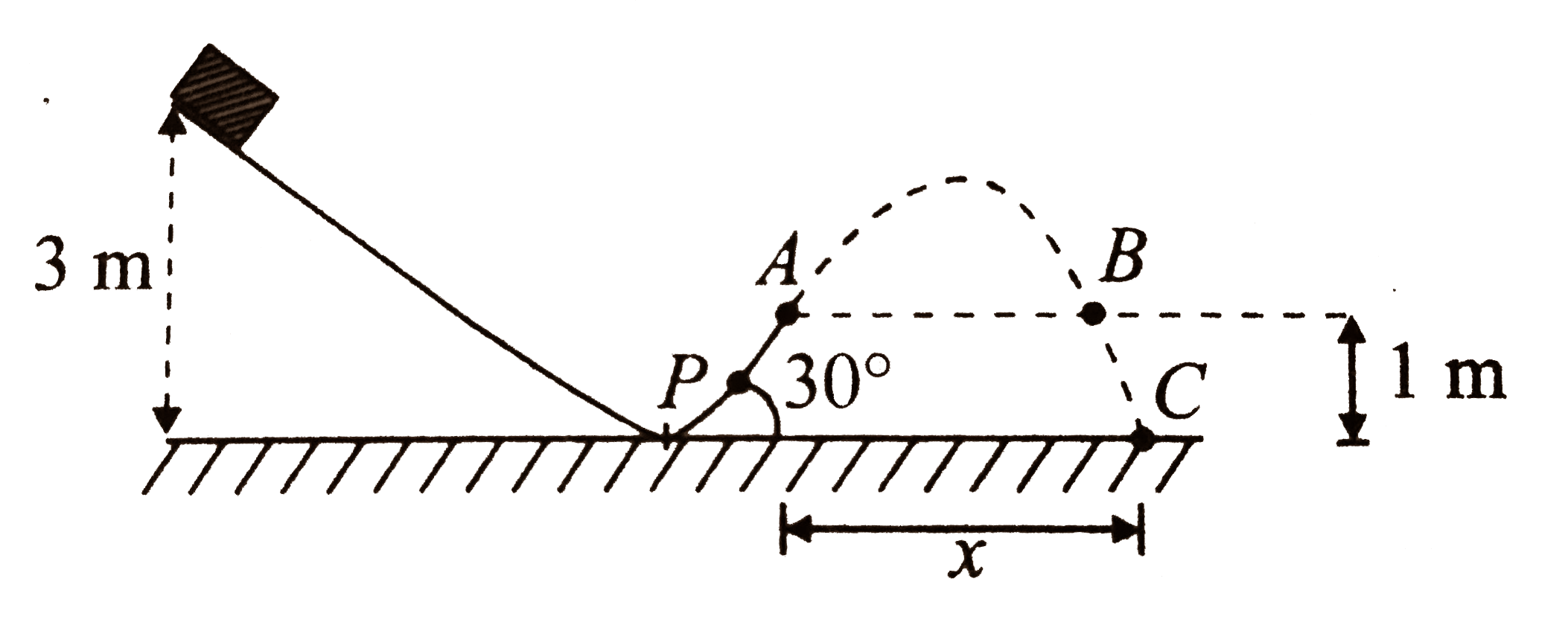A 0.098−kg block slides down a frictionless track as shown in (Fig. 5.208).
 .
.
The horizontal distance x travelled by the block in moving from A to C is.
(1+√3)m
(1−√3)m
(√3+3))m
g meter
The correct Answer is:C
(c) 12mv2=mg(3−1)=2mg [from conservation of energy]
or v=√4g=2√g
Vertical component at A is 2√gsin30∘=√g
Time of flight,
T=2vsinθg=2√gg=2√g
Using S=ut+12at2, we get
−1=√gt−12gt2or12gt2−√gt−1=0
t=√g±√g+4×12g2×g2t=1±√3√g
Neglecting negative time, t=1±√3√g
x=2√gcos30∘[1±√3√g]orx=(√3+3)m.
Topper's Solved these Questions
- KINEMATICS-2Book:CENGAGE PHYSICSChapter:KINEMATICS-2Exercise:Exercise Integer
Explore 9 Videos
- KINEMATICS-2Book:CENGAGE PHYSICSChapter:KINEMATICS-2Exercise:Exercise Assertion - Reasoning
Explore 5 Videos
- KINEMATICS-1Book:CENGAGE PHYSICSChapter:KINEMATICS-1Exercise:Integer
Explore 9 Videos
- KINETIC THEORY OF GASESBook:CENGAGE PHYSICSChapter:KINETIC THEORY OF GASESExercise:Compression
Explore 2 Videos
Similar Questions
A block slides down a curved frictionless track and then up an inclined plane as in figure. The coefficient of kinetic friction between the block and incline is μk. Find the maximum height reached by the clock.

View SolutionA block slides down a frictionless plane inclined at an angle θ. For what value of angle θ the horizontal component of acceleration of the block is maximum? Find this maximum horizontal acceleration.
View Solution
Knowledge Check
A 0.098−kg block slides down a frictionless track as shown in (Fig. 5.208).
 .
.
The time taken by the block to move from A to C is.A√3gB√2gC√1gD1+√3√gA 0.098−kg block slides down a frictionless track as shown in (Fig. 5.208).
 .
.
The time taken by the block to move from A to B is.A1√gB2√gC3√gD4√gA 0.098−kg block slides down a frictionless track as shown in (Fig. ).
 .
.
The vertical component of the velocity of block at A isA√gB2√gC3√gD4√g
All surfaces are smooth Find the horizontal displacements of the block and the wedge when the block slides down from top to bottom
 .
.
View SolutionTwo blocks A and B are connected to each other by a string and a spring , the string passes over a frictionless pulley as shown in the figure. Block B slides over the horizontal top surface of a stationary block C and the block A slides along the vertical side of C, both with the same uniform speed. The coefficient of friction between the surface and blocks is 0.5K=2000N/m. If mass of A is 2kg calculate mass of B.
 .
.
View SolutionA 5kg block slides down a plane inclined at 30∘ to the horizontal. Find
(a) The acceleration of the block if the plane is frictionless
(b) The acceleration if the coefficient of kinetic friciton is 0.2
View SolutionA block slides down a curved frictionless track and then up an inclined plane as in figure. The coefficient of kinetic friction between the block and incline is μk. Find the maximum height reached by the clock.

View SolutionTwo forces act on a 4.5 kg block resting on a frictionless surface as shown in the given figure. What is the magnitude of the horizontal acceleration of the block ?

View Solution